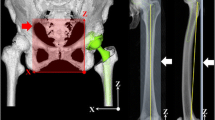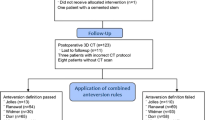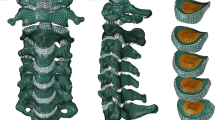Abstract
Dislocation remains a major complication after THA, and range of motion before impingement is important in joint stability. Variability in implant alignment affects resultant range of motion. We used a probabilistic modeling approach to assess the effects of implant alignment variability based on manual and computer-assisted surgical (CAS) techniques on resultant range of motion after THA. We implemented a contact detection algorithm within a probabilistic analysis framework. The normally distributed alignment variables (mean ± 1 standard deviation) were cup abduction (manual = 45° ± 7.6°, CAS = 45° ± 5.7°), cup anteversion (manual = 20° ± 9.6°, CAS = 20° ± 4.5°), and stem anteversion (manual and CAS = 10° ± 1.5°). The outcomes of the probabilistic analysis were range of motion distributions with 1% and 99% bounds. The upper bounds of motion for manual and CAS alignment were similar because bony impingement was the limiting factor. The lower bounds of range of motion were substantially different depending on the type of surgical alignment; manual alignment produced a smaller range of motion in 3% to 5% of cases. CAS implant alignment produced range of motion values above minimum acceptable levels in all cases simulated.

Similar content being viewed by others
References
Bartz RL, Nobel PC, Kadakia NR, Tullos HS. The effect of femoral component head size on posterior dislocation of the artificial hip joint. J Bone Joint Surg Am. 2000;82:1300–1307.
Daly PJ, Morrey BF. Operative correction of an unstable total hip arthroplasty. J Bone Joint Surg Am. 1992;74:1334–1343.
D’Lima DD, Urquhart AG, Buehler KO, Walker RH, Colwell CW. The effect of the orientation of the acetabular and femoral components on the range of motion of the hip at different head-neck ratios. J Bone Joint Surg Am. 2000;82:315–321.
Dorr LD, Wan Z. Causes of and treatment protocol for instability of total hip replacement. Clin Orthop Relat Res. 1998;355:144–151.
Easley S, Pal S, Tomaszewski P, Petrella A, Rullkoetter P, Laz P. Finite element-based probabilistic analysis tool for orthopaedic applications. Comput Methods Programs Biomed. 2007;85:32–40.
Fackler CD, Poss R. Dislocation in total hip arthroplasties. Clin Orthop Relat Res. 1980;151:169–178.
Grigoris P, Grecula MJ, Amstutz HC. Tripolar hip replacement for recurrent prosthetic dislocation. Clin Orthop Relat Res. 1994;304:148–155.
Haldar A, Mahadevan S. Probability, Reliability and Statistical Methods in Engineering Design. New York, NY: Wiley; 2000.
Harris WH. Advances in surgical technique for total hip replacement. Clin Orthop Relat Res. 1980;146:188–204.
Hedlundh U, Ahnfelt L, Hybbinette CH. Dislocations and the femoral head size in primary total hip arthroplasty. Clin Orthop Relat Res. 1996;333:226–233.
Jaramaz B, DiGioia III AM, Blackwell M, Nikou C. Computer assisted measurement of cup placement in total hip replacement. Clin Orthop Relat Res. 1998;354:70–81.
Jaramaz B, Nikou C, Simon D, DiGioia III A. Range of motion after total hip arthroplasty: experimental verification of the analytical simulator. Lect Notes Comput Sci. 1997;1205:573.
Jolles BM, Genoud P, Hoffmeyer P. Accuracy of computer-assisted cup placement in total hip arthroplasty. Int Congr Ser. 2001;1230:314–318.
Jolles BM, Genoud P, Hoffmeyer P. Computer-assisted cup placement techniques in total hip arthroplasty improve accuracy of placement. Clin Orthop Relat Res. 2004;426:174–179.
Kalteis T, Handel M, Herold T, Perlick L, Baethis H, Grifka J. Greater accuracy in positioning of the acetabular cup by using an image-free navigation system. Int Orthop. 2005;29:272–276.
Kessler O, Patil S, Stefan W, Mayr E, Colwell CW, D’Lima DD. Bony impingement affects range of motion after total hip arthroplasty: a subject-specific approach. J Orthop Res. 2008;26:443–452.
Kluess D, Martin H, Mittelmeier W, Schmitz K-P, Bader R. Influence of femoral head size on impingement, dislocation and stress distribution in total hip replacement. Med Eng Phys. 2007;29:465–471.
Lewinnek GE, Lewis JL, Tarr R, Compere CL, Zimmerman JR. Dislocations after total hip-replacement arthroplasties. J Bone Joint Surg Am. 1978;60:217–220.
McCollum DE, Gray WJ. Dislocation after total hip arthroplasty. Causes and prevention. Clin Orthop Relat Res. 1990;261:159–170.
Minoda Y, Kadowaki T, Kim M. Acetabular component orientation in 834 total hip arthroplasties using a manual technique. Clin Orthop Relat Res. 2006;445:186–191.
Morrey BF. Instability after total hip arthroplasty. Orthop Clin North Am. 1992;23:237–248.
Müller ME. Total hip prostheses. Clin Orthop Relat Res. 1970;72:46–68.
Nadzadi ME, Pedersen DR, Yack HJ, Callaghan JJ, Brown TD. Kinematics, kinetics, and finite element analysis of commonplace maneuvers at risk for total hip dislocation. J Biomech. 2003;36:577–591.
Parratte S, Argenson JA. Validation and usefulness of a computer-assisted cup-positioning system in total hip arthroplasty. A prospective, randomized, controlled study. J Bone Joint Surg Am. 2007;89:494–499.
Pierchon F, Pasquier G, Cotten A, Fontaine C, Clarisse J, Duquennoy A. Causes of dislocation of total hip arthroplasty. CT study of component alignment. J Bone Joint Surg Br. 1994;76:45–48.
Seel MJ, Hafez MA, Eckman K, Jaramaz B, Davidson D, DiGioia III AM. Three-dimensional planning and virtual radiographs in revision total hip arthroplasty for instability. Clin Orthop Relat Res. 2006;442:35–38.
Turner RS. Postoperative total hip prosthetic femoral head dislocations Incidence, etiologic factors, and management. Clin Orthop Relat Res. 1994;301:196–204.
VAKHUM. University of Brussels Web site. Available at: http://www.ulb.ac.be/project/vakhum. Accessed August 13, 2002.
Van Sint Jan S, Salvia P, Hilal I, Sholukha V, Rooze M, Clapworthy G. Registration of 6-DOFs electrogoniometry and CT medical imaging for 3D joint modeling. J Biomech. 2002;35:1475–1484.
White Jr RE, Forness TJ, Allman JK, Junick DW. Effect of posterior capsular repair on early dislocation in primary total hip replacement. Clin Orthop Relat Res. 2001;393:163–167.
Widmer KH, Majewski M. The impact of the CCD-angle on range of motion and cup positioning in total hip arthroplasty. Clin Biomech (Bristol Avon). 2005;20:723–728.
Widmer KH, Zurfluh B. Compliant positioning of total hip components for optimal range of motion. J Orthop Res. 2004;22:815–821.
Wines AP, McNicol D. Computed tomography measurement of the accuracy of component version in total hip arthroplasty. J Arthroplasty. 2006;21:696–701.
Woo RY, Morrey BF. Dislocations after total hip arthroplasty. J Bone Joint Surg Am. 1982;64:1295–1306.
Wu G, Siegler S, Allard P, Kirtley C, Leardini A, Rosenbaum D, Whittle M, D’Lima DD, Cristofolini L, Witte H, Schmid O, Stokes I. ISB recommendation on definitions of joint coordinate system of various joints for the reporting of human joint motion—part I: ankle, hip, and spine. J Biomech. 2002;35:543–548.
Wu Y-T, Millwater HR, Cruse TA. Advanced probabilistic structural analysis method for implicit performance functions. J AIAA. 1990;28:1663–1669.
Yoshimine F. The safe-zones for combined cup and neck anteversions that fulfill the essential range of motion and their optimum combination in total hip replacements. J Biomech. 2006;39:1315–1323.
Yoshimine F, Ginbayashi K. A mathematical formula to calculate the theoretical range of motion for total hip replacement. J Biomech. 2002;35:989–993.
Yuan L, Shih C. Dislocation after total hip arthroplasty. Arch Orthop Trauma Surg. 1999;119:263–266.
Acknowledgments
We thank Clifford W. Colwell, Jr. MD for his assistance with the surgical technique and Oliver Kessler, MD for providing the CAD models.
Author information
Authors and Affiliations
Corresponding author
Additional information
All authors certify that they have no commercial associations (e.g., consultancies, stock ownership, equity interest, patent/licensing arrangements, etc.) that might pose a conflict of interest in connection with the submitted article.
About this article
Cite this article
Petrella, A.J., Stowe, J.Q., D’Lima, D.D. et al. Computer-assisted versus Manual Alignment in THA: A Probabilistic Approach to Range of Motion. Clin Orthop Relat Res 467, 50–55 (2009). https://doi.org/10.1007/s11999-008-0561-4
Received:
Accepted:
Published:
Issue Date:
DOI: https://doi.org/10.1007/s11999-008-0561-4




